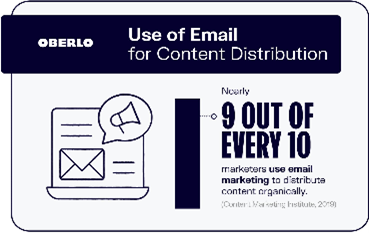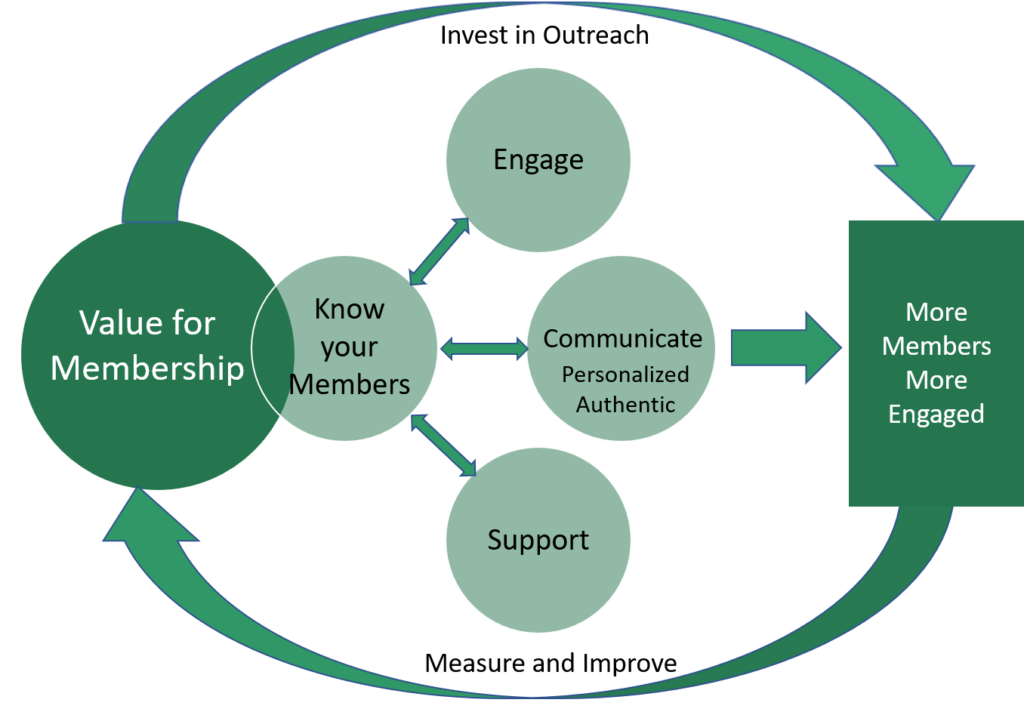8 Ways to Foster Member Loyalty
- Nov 15, 2020
- Kathy Edersheim
- 18 min. reading
Each organization and its community are unique based on the purpose and the membership. Yet there are some “universal truths” that need to be recognized so that the entity will grow and thrive. First and foremost, if you are leading a membership-based organization, it is about the members and must be managed accordingly. Here are 8 steps to a more loyal and engaged membership.
1. Give Members Value
Whether they know it or not, members think about the value of membership relative to the cost (return on investment) every time they receive a renewal reminder. So, if the benefits of membership are weak or meager especially compared to the cost, you will lose members each time you ask for dues. And many people will never join at all because of it.
When members know from experience that the value of membership is greater than the costs, they will renewal eagerly which is important for the long-term health of the organization. In addition, members are far more likely to become actively involved when they understand the benefits of membership.
While you are providing these benefits of membership, make sure to communicate about them (in Step 3.)
2. Prioritize Membership, Membership, Membership
If the three most important elements of real estate are “location, location, location” then, for an organization, the priorities are members, members, members. To be a bit more specific, it is about current members (remember that value proposition), renewing members, and finding new members.
Every organization needs a system for renewing members, usually something on-line supplemented by mail as needed. When the system works and people click through to renew (or have auto-renew!), everything is great. What about when they do not? Stay in touch! Past members are your most likely new members just the way past donors are your best prospects. They understand the organization and were interested before so there is a good chance that they will be supportive again.
To be successful at reengaging, you need to understand why someone did not renew. It could be for any number of reasons – they moved, they didn’t see the email, they found a new interest, they forgot, they don’t see the value of membership (Point 1), they aged out or, occasionally, because they were unhappy with the organization for some reason. In many situations, there is good reason to believe that they can be brought back with the right effort.
Spend some time talking with people to figure it out so that you can take the right steps such as improving the benefits of membership or the communication of benefits. Take advantage of emails and free events to keep lapsed members informed but do not offer them too many discounts or freebies as that undermines the value of membership for them and for others (why pay dues when they can still get the benefits?)
That brings us to the question of where you will find new members. An organization needs to know the profile of its members and potential new members to develop a strong member acquisition strategy. For all entities, referrals by existing members is the best, least costly way to bring in new members. Word-of-mouth referrals are likely to be well informed about the organization and will already have a friend among the membership. There are many ways to structure a member-get-member program that reward the existing member and sometimes the new member. Make sure to include this type of program in your membership plan.
3. Send Lots of (Good) Emails to Members

Email is the most effective broad communication tool for organizations in the United States. According to HubSpot, 73% of millennials prefer communications from businesses to come via email. Email is consistently more cost efficient than mail and more effective than social media.
Email is the most effective broad communication tool for organizations in the United States. According to HubSpot, 73% of millennials prefer communications from businesses to come via email. Email is consistently more cost efficient than mail and more effective than social media.
The next question is how often to email your members? The answer depends on the nature of the organization and the community. Keep in mind that entities often email 2 – 3 times a week or even daily and maintain or grow the constituency. Whether a corporate identity or cause oriented – you need to know your audience. You can read more about the importance of emails and how to make them great at 360Alumni Email Series.
The key is to make sure that you are sending interesting and visually appealing emails. Emails need good content and a call to action. They also have to “look” like the organization to keep the brand top of mind. Try to establish a regular schedule for emails with a variety of content to appeal to the breadth of the membership. And, if you don’t have anything interesting to say, don’t try to fake it.
As you send your emails and follow a communications plan, remember to watch the results - bounces, opens, click through rates, likes, and re-posts to determine what resonates with your audience. With this valuable information, you can decide how to balance email content, social media, and timing.
4. Focus on Members
An organization that has members with shared purpose must be about the members and achieving the purpose, not about the organization. Structure, communications, and engagement must focus on the members. When you send an update about the organization, it should be about the members or the purpose through a success story, announcement of enhanced member benefit (such as new gym equipment for member use,) or furthering the cause.
Inward looking communications that talk about new hires or what the CEO did last week tell the members that it is about management instead of members. It will not be long before the members stop reading the emails and end their engagement if not their membership. Gary Toyn explained it well when he referred to “… a narcissistic organization [that] is preoccupied with themselves, and will always talk about themselves, instead of talking about what they can do for their members” in How to Scare Away Member Loyalty and Engagement in 10 Easy Steps (which provided the idea for this post.)
5. Personalize Communications
The most appealing sound for a person is their own name. We all want to be recognized, known, and heard especially within our community. A small organization might have the luxury to have meetings and calls where each person is connected directly. As an organization grows, communications have to be by email or letter, but they must remain personal.
Good news: there are many ways to manage members (CRMs) and send emails/letters that are personalized. It is a new paradigm in communications thanks to technology. There is tremendous benefit if you take the extra time to create communications for multiple demographic segments with personalization.
According to Campaign Monitor, emails with personalized subject lines are 26% more likely to be opened.

And Oberlo says 50% more likely. Click through rates (CTR) were 18% higher in 2018 according to Segmentify. Personalized calls to action convert 202% better than default calls to action according to HubSpot. Plus, it lowers your unsubscribe rate.
The benefits of personalization are clear. Start now!
6. Invest in Outreach
Every organization wants engagement of some sort whether it is leadership, participation, or financial contribution or a combination of these. Your members need to understand what you want, why you want it, and how to provide it. That is outreach. You need the resources to connect with each person individually and align the ask with their interests as mentioned above. Who will do this?
You need people and tools to make things happen. Sometimes you can call on volunteers and free software but not all the time. It is vital to invest wisely. You need people who understand the organization and the members then you need the tools to make them effective and efficient such as a good CRM and a fully functional email system with automations, segmenting, etc. You can find a list of some CRM companies at https://impactrics.com/resources/database-crm-options/.
7. Meet Your Members Where They Are
During the pandemic, so many members can be found at home in front of a screen. So, it should be easier to meet them there. But it is about their mental place as well as the physical so there is still a lot of work to be done. In fact, there may be more competition for attention with all the virtual content and functionality being offered by so many.
You should consider what you are offering members in terms of content (webinars, communications, resources) and functionality from social interaction to learning to payment methods. Yes, it must be on-line and easy. It should also be functional on mobile devices. As mentioned in Step 2, you should also offer autorenewal because one of the top reasons members do not renew is because they simply forget (many systems also allow monthly payment which can be helpful.)
There may be some cost to a streamlined operation such as a better designed website to minimize clicks and an on-line payment system to collect donations and dues, but it is worth it. You might find a free system that works for you or you might be able to embed the costs in slightly higher dues. Remember that doing more on-line can save the hefty costs of mailing. Take the time to research the best choices of software and design for the organization based on cost and functionality.
While you take this opportunity to make your operation virtual, remember to plan for a return to some in-person events (content providing and fundraising) and to continue to serve members who want to use mail as well as email.
8. Measure Something
How do you know when you are successful? Is it the number of people at an event? The number of donors? The amount of donations? The number of members? Or is it the change in one (or more) of these measures from one year to the next? Do you look at the trends?
When you know your priorities and what you are trying to accomplish, you can find something to measure that will indicate success. Choosing what to measure and how to measure it is crucial for making decisions about future efforts.
In terms of membership, at the very least, measure retention and new memberships because
1. You must have members.
2. Membership indicates if members are happy. In other words, it reflects the success of engagement and communications.
Happily, it is also easy to measure.
Most importantly, when you know what is going on with membership, you can adapt or change your efforts for further success as discussed earlier. There is some helpful guidance on membership metrics at 4 Options for Tracking Vital Membership Metrics by the Membership Guys. Note that you can and should look at the rate at which members leave your organization which is the churn. Analyzing and understanding why members leave can reveal patterns and be an early alert to problems. Gary Toyn provides some good insight into this in How to Scare Away Member Loyalty and Engagement in 10 Easy Steps.
For an organization that is fundraising or interested in promoting sales (corporate community), the financial side can be tracked as well.
Summary
Here is a visual summary of what it takes to attract and engage loyal members:

Know your purpose, know your members. Engage your members, support your purpose.
